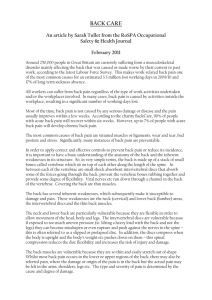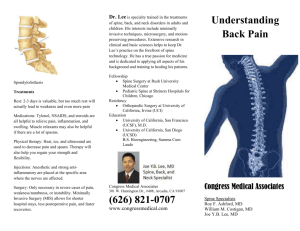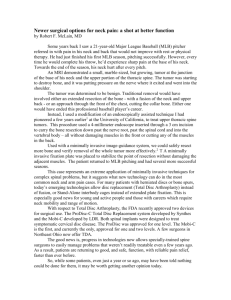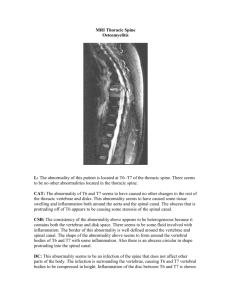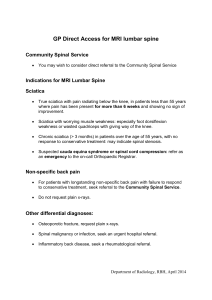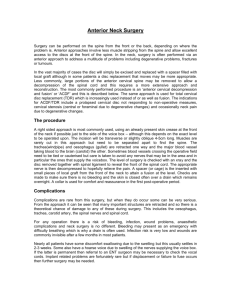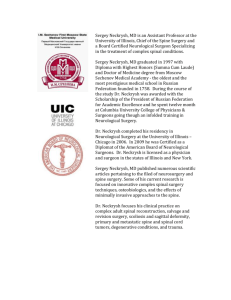neck_and_back_pain
advertisement
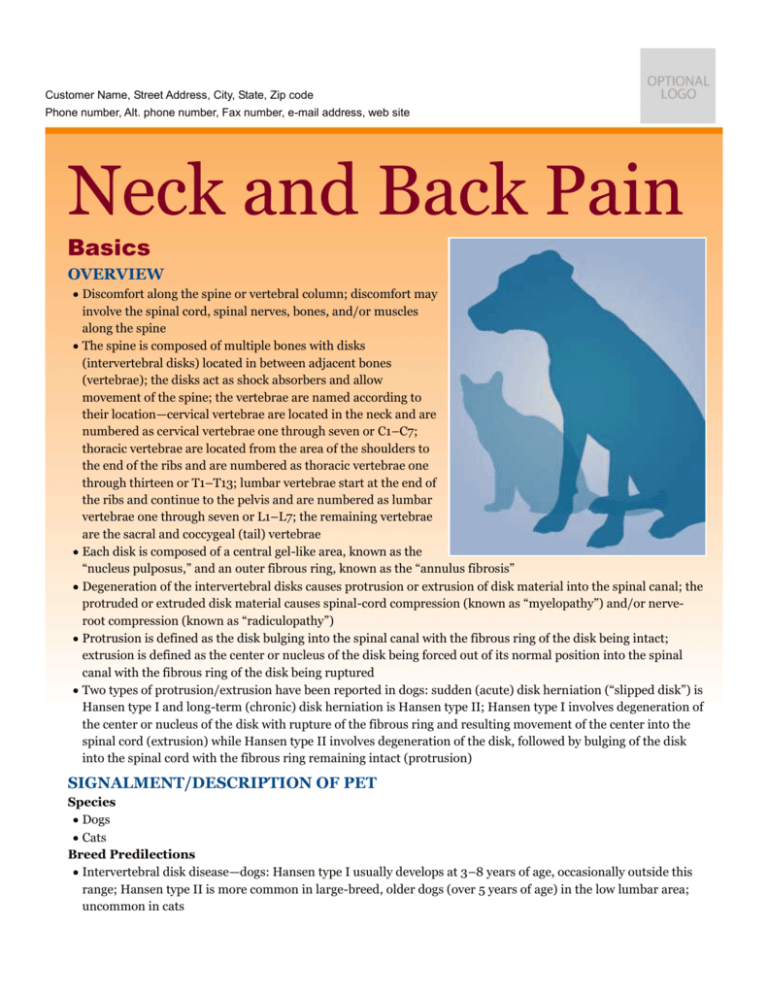
Customer Name, Street Address, City, State, Zip code Phone number, Alt. phone number, Fax number, e-mail address, web site Neck and Back Pain Basics OVERVIEW • Discomfort along the spine or vertebral column; discomfort may involve the spinal cord, spinal nerves, bones, and/or muscles along the spine • The spine is composed of multiple bones with disks (intervertebral disks) located in between adjacent bones (vertebrae); the disks act as shock absorbers and allow movement of the spine; the vertebrae are named according to their location—cervical vertebrae are located in the neck and are numbered as cervical vertebrae one through seven or C1–C7; thoracic vertebrae are located from the area of the shoulders to the end of the ribs and are numbered as thoracic vertebrae one through thirteen or T1–T13; lumbar vertebrae start at the end of the ribs and continue to the pelvis and are numbered as lumbar vertebrae one through seven or L1–L7; the remaining vertebrae are the sacral and coccygeal (tail) vertebrae • Each disk is composed of a central gel-like area, known as the “nucleus pulposus,” and an outer fibrous ring, known as the “annulus fibrosis” • Degeneration of the intervertebral disks causes protrusion or extrusion of disk material into the spinal canal; the protruded or extruded disk material causes spinal-cord compression (known as “myelopathy”) and/or nerveroot compression (known as “radiculopathy”) • Protrusion is defined as the disk bulging into the spinal canal with the fibrous ring of the disk being intact; extrusion is defined as the center or nucleus of the disk being forced out of its normal position into the spinal canal with the fibrous ring of the disk being ruptured • Two types of protrusion/extrusion have been reported in dogs: sudden (acute) disk herniation (“slipped disk”) is Hansen type I and long-term (chronic) disk herniation is Hansen type II; Hansen type I involves degeneration of the center or nucleus of the disk with rupture of the fibrous ring and resulting movement of the center into the spinal cord (extrusion) while Hansen type II involves degeneration of the disk, followed by bulging of the disk into the spinal cord with the fibrous ring remaining intact (protrusion) SIGNALMENT/DESCRIPTION OF PET Species • Dogs • Cats Breed Predilections • Intervertebral disk disease—dogs: Hansen type I usually develops at 3–8 years of age, occasionally outside this range; Hansen type II is more common in large-breed, older dogs (over 5 years of age) in the low lumbar area; uncommon in cats • Cervical spondylomyelopathy or “Wobbler” syndrome (condition affecting the cervical spine, in which the spinal cord is compressed; may involve the intervertebral disks or abnormal bones [vertebrae])—large-breed dogs; Doberman pinscher, Great Dane, rottweiler, and Dalmatian; more often in middle-aged to older Doberman pinschers (disk-related) and young Great Danes (abnormal formation and/or abnormal movement of the bones [vertebrae] in the neck) • Dislocation of the joint between the first and second cervical vertebra (condition known as “atlantoaxial luxation”) and partial dislocation of the joint between the first and second cervical vertebra (condition known as “atlantoaxial subluxation”)—most often occurs in young to middle-aged miniature breeds (such as the Yorkshire terrier); any breed or age may be affected, if trauma induced • Steroid-responsive inflammation of the membranes covering the brain and spinal cord (membranes known as “meninges”; condition known as “meningitis”) and inflammation of the arteries (known as “arteritis”)—dogs less than 2 years of age; Bernese mountain dog, boxer, and beagle • Caudal occipital malformation syndrome—Cavalier King Charles spaniel • Immune-mediated inflammation of several muscles (known as “immune-mediated polymyositis”)— Newfoundland, boxer • Bacterial or fungal infection of the intervertebral disks and adjacent bone of the spine (vertebral bodies; condition known as “diskospondylitis”)—dogs; intact breeding dogs susceptible to Brucella diskospondylitis • Musculoskeletal trauma—any age or breed SIGNS/OBSERVED CHANGES IN THE PET • Perceived discomfort of the pet (such as reluctance to get up or lie down, reluctance to go up or down stairs, difficulty squatting to urinate or defecate, difficulty getting into vehicles) • Head down posture—neck pain (neck pain may be intermittent) • Abnormal neck carriage • Reluctance to move head in various directions—stiff neck • Arched back—neck or back pain • Pain on feeling the epaxial muscles (muscles along the spine) • Rigidity of the epaxial muscle (muscles along the spine) • Guarded posture • Reluctance to walk—guarded short stride • Low-grade fever—primarily in pets with involvement of the membranes covering the brain and spinal cord (meninges) or bacterial or fungal infection of the intervertebral disks and adjacent bone of the spine (diskospondylitis) CAUSES Epaxial Muscles (Muscles along the Spine) • Inflammation of the muscles secondary to trauma (known as “traumatic myositis”) • Inflammation of several muscles (polymyositis) • Disorder following exercise that leads to injury and destruction of skeletal muscle tissue (known as “exertional rhabdomyolysis”) • Muscle cancer—rhabdomyosarcoma • Infectious inflammation of the muscles (infectious myositis)—parasitic, bacterial, protozoal • Immune-mediated inflammation of the muscles (immune-mediated myositis) • Foreign-body inflammation of the muscles (foreign-body myositis)—grass-awn migration Backbone (Vertebra) and Associated Structures • Intervertebral disk disease—most common cause of spinal pain in dogs • Cervical spondylomyelopathy or “Wobbler” syndrome (condition affecting the cervical spine, in which the spinal cord is compressed; may involve the intervertebral disks or abnormal bones [vertebrae]) • Bacterial or fungal infection of the intervertebral disks and adjacent bone of the spine (diskospondylitis) • Osteoarthritis (form of joint inflammation [arthritis] characterized by chronic deterioration or degeneration of the joint cartilage) of the articular facets (surfaces of the backbone [vertebra] where it joins together with another backbone) • Unstable structural abnormalities of the backbones—hemivertebra (incomplete development of one side of a vertebra) and dislocation of the joint between the first and second cervical vertebra (atlantoaxial luxation) or partial dislocation of the joint between the first and second cervical vertebra (atlantoaxial subluxation) • Cancer of the backbone (vertebra)—osteosarcoma, chondrosarcoma, multiple myeloma, and cancer that has spread to the spine (known as “metastatic cancer”) • Infection/inflammation of the backbone (vertebra; condition known as “vertebral osteomyelitis”) • Fracture • Dislocation (known as “luxation”) and partial dislocation (known as “subluxation”) • Abnormal formation and abnormal movement of the backbones (vertebrae) Spinal Nerves • Entrapment of the spinal nerve by intervertebral disk herniation • Tumors or cancer—neurofibroma, neurofibrosarcoma, and peripheral nerve sheath tumor • Traumatic entrapment, tearing, or laceration of the spinal nerves • Inflammation of the nerves (known as “neuritis”)—viral, bacterial, and parasitic • Compression or inflammation of spinal nerves at the point where they enter the spine or vertebral column Meninges (Membranes Covering the Brain and Spinal Cord) • Tumors or cancer—meningioma and cancer that has spread to the meninges (metastatic cancer) • Inflammation of the meninges (known as “meningitis”)—bacterial, viral, parasitic, protozoal, rickettsial, of immune-mediated disease or of unknown cause (so-called “idiopathic disease”) RISK FACTORS • Breeds with “normal” short, bowed legs (known as “chondrodysplastic breeds”)—intervertebral disk disease • Trauma • Previous surgical procedure • Bite wound, foreign body • Urinary tract infection • Feline leukemia virus (FeLV) infection—spinal lymphoma; “lymphoma” is a type of cancer that develops from lymphoid tissue, including lymphocytes, a type of white blood cell formed in lymphatic tissues throughout the body • Very active pet—for example, asked to jump a lot (such as working police dogs) • Previous diagnosis of cancer Treatment HEALTH CARE • Varies widely according to the nature and extent of the lesion and tissues involved • The cause of the neck or back pain should be diagnosed before symptomatic treatment is started • Inpatient versus outpatient—depends on severity of disease • Acupuncture—may alleviate neck/back pain • Pets that cannot walk (known as being “non-ambulatory”)—soft, padded bedding; turn frequently to prevent pressure sores • Unstable spine—use extreme care in moving to avoid increasing injury to the spine ACTIVITY • Depends on underlying cause of neck or back pain • Restrict exercise at least 3–4 weeks in pets treated medically SURGERY • Surgical intervention—may be indicated for intervertebral disk herniation, trauma, congenital (present at birth) spinal abnormalities, and tumors/cancer; a foreign body may require surgical removal or drainage to treat an associated abscess • Emergency surgery—if the spine is unstable following trauma or if the pet has severe nervous system abnormalities (such as being unable to walk or paralyzed) due to sudden (acute) pressure on the spinal cord Medications Medications presented in this section are intended to provide general information about possible treatment. The treatment for a particular condition may evolve as medical advances are made; therefore, the medications should not be considered as all inclusive • Medications prescribed by your pet's veterinarian will be based on clinical signs (such as pain) and diagnosis; examples include the following: Pain relievers (known as “analgesics”)—tramadol, morphine, hydromorphone, fentanyl patch Steroids—may be required; depends on the diagnosis; prednisone Nonsteroidal anti-inflammatory drugs (NSAIDs)—meloxicam, carprofen; used to decrease pain and inflammation Antibiotics—for infection; depends on the causative agent Gabapentin, pregabalin, or tricyclic antidepressants—used to treat long-term (chronic) nerve-related pain Drugs to decrease the immune response (known as “immunosuppressive drugs”)—azathioprine, cyclosporine Chemotherapy or radiation therapy—for cancer; depends on tumor type Muscle relaxants—benzodiazepine, methocarbamol Follow-Up Care PATIENT MONITORING • Monitor response to treatment closely and make adjustments as necessary; initially. Monitor at least weekly • Watch for signs of inflammation of the stomach and intestines (known as “gastroenteritis”) and the bladder (known as “cystitis”) • Bloodwork, spinal and chest x-rays (radiographs), ultrasound examinations, and cerebrospinal fluid analysis may be indicated, based on type of disease causing neck and/or back pain; “cerebrospinal fluid” (also known as CSF) is a specialized body fluid that cushions the brain and spinal cord PREVENTIONS AND AVOIDANCE • Avoid excessive activity, jumping, and going up or downstairs • Avoid excess weight • Avoid use of neck collars POSSIBLE COMPLICATIONS • Recurrence of neck and/or back pain • Deterioration of clinical signs; surgical treatment on an emergency basis may be needed • Long-term (chronic), unresponsive pain • Permanent nervous system dysfunction • Spread of disease (such as infections or cancer) to other locations • Fractures of the spine occurring at the site of weakened bone (known as “pathologic fractures”) • “Degenerative joint disease” or DJD (progressive and permanent deterioration of joint cartilage) EXPECTED COURSE AND PROGNOSIS • Varies with cause of neck and/or back pain, severity of clinical signs, and nervous system deficits • Recurrence of neck and/or back pain is common in many diseases • Intervertebral disk disease Hansen type I—success with medical treatment in dogs with only pain or mild nervous system deficits is about 50% Key Points • Discomfort along the spine or vertebral column; discomfort may involve the spinal cord, spinal nerves, bones, and/or muscles along the spine • Perceived discomfort of the pet (such as reluctance to get up or lie down, reluctance to go up or down stairs, difficulty squatting to urinate or defecate, difficulty getting into vehicles) • The cause of the neck or back pain should be diagnosed before symptomatic treatment is started • Most common cause of neck and back pain in dogs is intervertebral disk disease Enter notes here Blackwell's Five-Minute Veterinary Consult: Canine and Feline, Fifth Edition, Larry P. Tilley and Francis W.K. Smith, Jr. © 2011 John Wiley & Sons, Inc.

